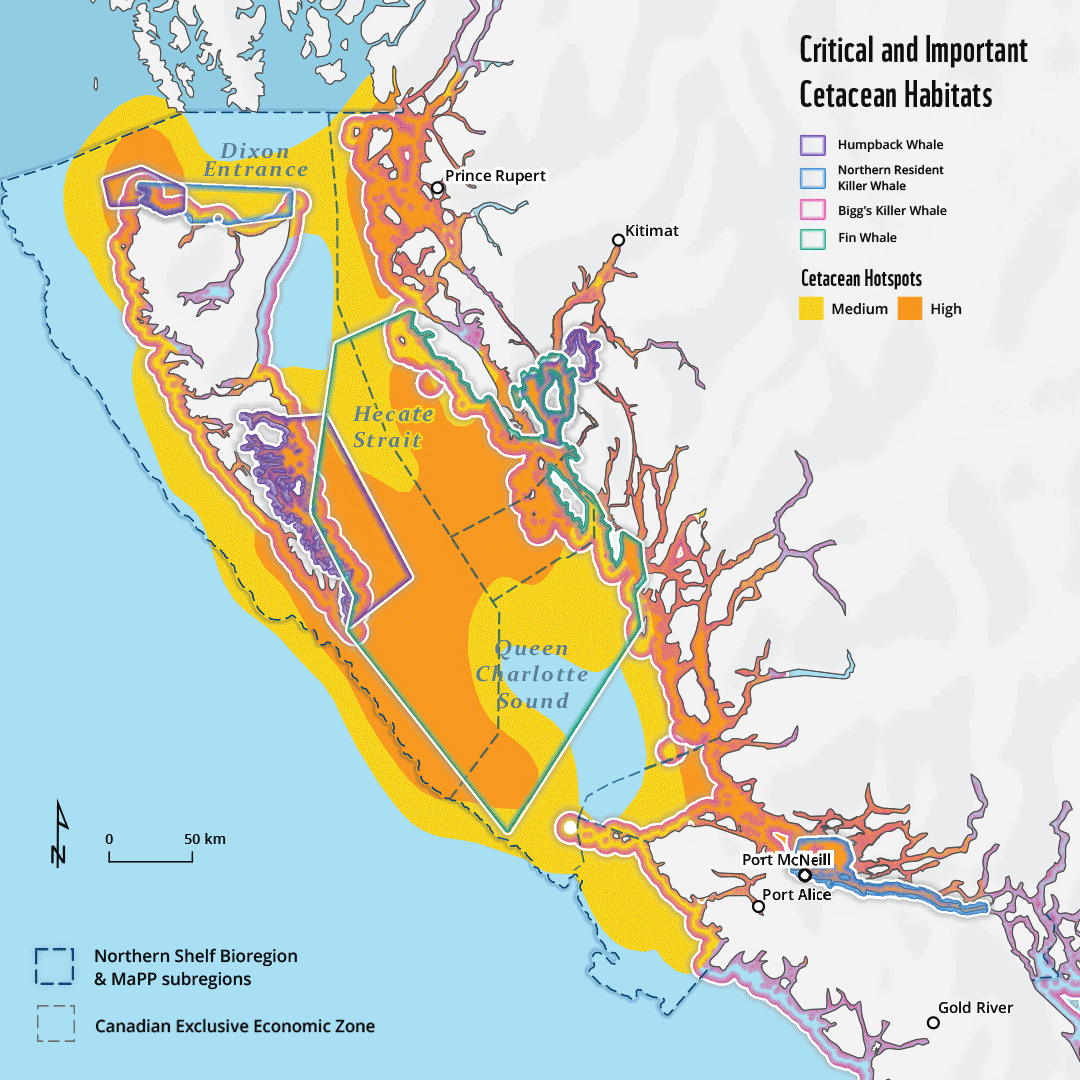Shipping speed and waste are an ‘urgent’ threat in Great Bear Sea, WWF-Canada study finds
New analysis shows that traffic in this rapidly developing coastal region poses immediate and cumulative risks to at-risk marine species
GREAT BEAR SEA, B.C. —A new report by WWF-Canada uses data on ship speed and waste generated in B.C.’s Northern Shelf Bioregion, also known as the Great Bear Sea, to show the extent to which significant shipping traffic in one of the country’s rapidly developing coastal regions poses a direct and urgent threat to the region’s endangered cetacean species.
The analysis shows that shipping speeds, combined with billions of litres of waste, pose immediate and cumulative risks to species at risk, including fin whales and humpbacks. It builds on the data and findings from WWF-Canada’s Shipping Traffic and Speed in Cetacean Habitats on Canada’s Pacific Coast and National Vessel Dumping Assessment.
In 2022, an estimated 59 billion litres of waste were generated by commercial ships in the Northern Shelf Bioregion. When compared to an estimated 203 billion litres of harmful waste dumped in Canadian waters each year, the region represents a staggering 29 per cent of the estimated country-wide total.
And while “discharge” describes a range of waste types – including sewage, greywater (from sinks, showers, bathtubs, kitchens and laundry), and industry-specific waste such as oily bilge water – more than half of the bioregion’s waste was from scrubber washwater, a mixture of seawater and dissolved metals, acids and other harmful compounds. Since 2017, the number of ships fitted with scrubbers globally has increased by 1,500 per cent.
The harmful substances present in ship discharges have been linked to serious health problems in whales, fish and invertebrates — problems such as decreased fertility, compromised immunity, and increased rates of cancer, deformities and mortality.
The analysis shows a geographical correlation between ship speed and discharge (i.e., dumping of waste), where the highest regular concentration of ships travelling more than 10 knots — that is, at speeds that are far more likely to be lethal to whales if struck — is also where discharge volumes are highest. These areas also intersect with critical whale habitat, placing these species at high risk and increasing the urgent need for mitigation measures.

This looped image shows critical and important habitat (in yellow and orange) for at-risk whale populations and both ship speed and discharge data that was visualized as part of the WWF-Canada report (in purple and blue). The results are clear: excessive ship speed and shipping-related pollution are concentrated where critical whale habitat is observed, placing these species at high risk, and making the need for mitigation measures more urgent.
Given these clear results, WWF-Canada calls on industry and government to immediately:
- manage and monitor vessel speeds in all high-risk areas when the presence of whales seasonally increases, through regulatory or non-regulatory measures;
- collaborate with regulators and maritime stakeholders to identify and expand efforts to re-route vessels within the region away from critical whale habitat, using regulatory or non-regulatory measures that reduce the risk of shipping impacts in high-risk areas;
- implement the Marine Protected Area (MPA) Protection Standard’s enhanced vessel discharge restrictions in existing and future protected areas; and
- take additional steps to reduce chronic pollution in Canadian waters by:
-
- not approving scrubbers for use on Canadian ships,
- banning scrubber discharges in Canadian waters,
- defining treatment standards for greywater,
- expanding the enhanced measures for cruise ships to include additional wastes, such as scrubber washwater and other vessel types,
- increasing regulation and incentivization for the shipping industry to transition towards alternative clean fuels and green shipping technologies in Canadian waters.
Read the complete report here.
For more on the Great Bear Sea MPA Network, visit wwf.ca/great-bear-sea/
For more information, including media inquiries, please contact:
Erin Saunders, Communications Specialist, WWF-Canada, [email protected]
About World Wildlife Fund Canada
WWF-Canada is committed to equitable and effective conservation actions that restore nature, reverse wildlife loss and fight climate change. We draw on scientific analysis and Indigenous guidance to ensure all our efforts connect to a single goal: a future where wildlife, nature and people thrive. For more information visit wwf.ca.

